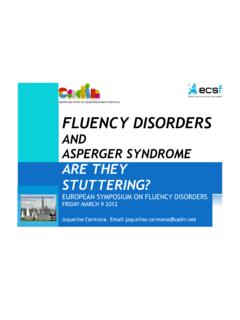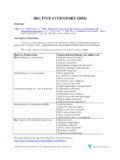Transcription of Treatment of the young stuttering child with Mini …
1 Treatment of the youngstuttering child with mini -KIDS1st European Symposium onFluency Disorders, Antwerp,Belgium, 18 & 19 April 2008 Peter SchneiderSchool for LogopedicsUniversity Hospital AachenGermanyPeter Schneider, Aachen2 Content Why stuttering modification withchildren? mini -KIDS Demands on the SLT Problems and benefitsPeter Schneider, Aachen3 young children are aware ofstuttering young stuttering children estimate theirown speaking significantly worse thanpeers (Vanryckeghem et al 2005) Preventing strategies whispering orsingsong Overt emotional reactionsPeter Schneider, Aachen4 Rationale of early interventionHyperfunctionalselfmonitorin gAwarenessStruggleDisfluencyLinguistic+ motoricfragilityEnvironmentBernstein Ratner 2008 - modifiedPeter Schneider, Aachen5 Intervention has to focus on Environmental factors supporting reactions towards stuttering Fluency facilitating communication ChildFunctional coping: Decrease of tension and time pressure during symptoms Decrease of shame or guilt Increase of tolerance concerning mistakes Increase of self-esteem as a competent speakerReducing risks ( speech and language disorder)Peter Schneider, Aachen6 Early intervention prevents chronic stuttering in many cases(Curlee 1999, Onslow & Packman 1999,Reardon & Yaruss 2003, Yaruss et al 2006) Short intervention in most casesPeter Schneider, Aachen7 stuttering ModificationObjective: optimal coping Short and easy symptoms Calm and assertive reactions to stuttering Self-esteem as a competent speakerSteps Desensitisation against stuttering and triggers Identification of overt/covered stuttering behaviour Modification of stuttering behaviour Generalisation of easy assertive stutteringPeter Schneider, Aachen8 stuttering Modification , 1973C.
2 Dell, 1979 Antwerp Model, L. Larsson, P. Zebrowki, S. Yaruss,N. Reardon, V. Waelkens,KIDS (P. Sandrieser & P. Schneider)and many others apply essential elements of stutteringmodification to the Treatment of young childrenPeter Schneider, Aachen9 KIDSK inder d rfen stotternTranslation:Children are allowed to stutterWe should show them good coping strategiesthat frequently induce recoveryPeter Schneider, Aachen10 Why should children beallowed to stutter?It prevents dysfunctional coping it is not allowed to stutter failure if it occurs efforts to get out of it > struggling attempts to avoid it negative reactions of environment inducesecondary emotions shame and guilt > riskfor self-esteemPeter Schneider, Aachen11 Why should it be allowed totalk about stuttering ?It prevents dysfunctional coping it is not allowed to talk about stuttering taboo imagination and concerns about reasons andfuture no relief and consolationfor both - child and parentsPeter Schneider, Aachen12 Disruptingself reinforcingprocesses!
3 Functional coping instead of Automation of motor reactions Psychological reactions Irritations in the environment Prejudicesin order to reduce the maintaining factors and toincrease the chance of recoveryPeter Schneider, Aachen13 Objective of mini -KIDS:Recovery induced by a modified stuttering as astep towards fluent speech Short and easy symptoms Calm and assertive reactions to stuttering Self-esteem as a competent speaker induced by reduction of other risksPeter Schneider, Aachen14 Side-effects in case of norecovery: Reduction of dysfunctional motor reactions dysfunctional psychological reactions Ability to control the remaining tensedstuttering events to some extent More competence in the environmentOnly effects, that persist in everyday situationsafter the end of the Treatment may be calledsuccessMini-KIDSP atricia Sandrieser &Peter Schneider(2002)Peter Schneider, Aachen16 Assessment Parental interview and questionnaires Spontaneous speech of the child Observation of general communicationand concerning stuttering Observation of reactions to the SLTsstuttering and to the topic of stuttering Assessment of other possible risksPeter Schneider, Aachen17 Treatment indicationStuttering with motor reactions ( struggling) cognitive and emotional reactions ( )
4 Concerns in the environment associated speech and language disorder other risks in the child and his environmentPeter Schneider, Aachen18 Information and agreement Information of the parents about theobjectives and the proceeding of mini -KIDS and alternative approaches agreement with the parents 1 - 2 sessions a week One parent takes part during the session and does the homeassignments with the child Both parents take part in a parental group and individualcounsellingPeter Schneider, Aachen19 Parental counselling -individual and in groups Symptomatology, epidemiology Multifactorial causes Maintaining factors Reacting towards stuttering Social environment, dealing with prejudices, bullying Fluency facilitating behaviour Comparison of Treatment approaches Self-help groupsPeter Schneider, Aachen20 Principles Good relationship between SLT, childand parents Continuous updating of assessmentand parental interview in order to fit thetreatment planPeter Schneider, Aachen21 stuttering modificationcombined with an individuallyplanned framework treatmentof risks Treatment of speech and languagedisorder Increasing self-esteem andassertiveness Improving turn-taking within the family Improving problem solving strategiesPeter Schneider, Aachen22 Phases Desensitisation and identification Modification GeneralisationPeter Schneider, Aachen23 Agreement with the parentsand the child Your mother, you and I will play andwork together and I will show you howyou can bring out your words easily ifthey get stuck and how you are lessembarrassed by the Schneider, Aachen24 Desensitisation - principles The therapist always stutters first.
5 If possible, the child determines the SLT s stuttering Descriptive feedback is better than judging Go out of the practice rooms as soon as possiblePeter Schneider, Aachen25 Desensitisation - cooperationwith the parents One parent learns the exercises Training at home as soon as the parent isable to motivate the child give a supporting feedback show a good pseudostuttering Continuous feedback about the homeassignment to the SLTP eter Schneider, Aachen26 Talking aboutreactions of otherstowards stutteringA stuttering hedgehog rescuesthe animals of the wood in spite of theirnegative reactions to his stuttering Peter Schneider, Aachen27 Teaching knowledge aboutstuttering Repetitions - frog words Detection Discrimination ProductionPeter Schneider, Aachen28 Prolongations - Snake-wordsDurationPeter Schneider, Aachen29In vivo desensitisationSide effect:increasingassertivenessPeter Schneider, Aachen30 Information at nursery school child and SLT inform the class aboutstuttering Comparison with other children who are different Exercise of frog words with the children Discussion how to react in a fair way tostutteringPeter Schneider, Aachen31 Blocks - Pooh - wordsPeter Schneider, Aachen32 TensionPeter Schneider, Aachen33 Identification of pseudo andtrue symptomsPlaying tag Who notices the stutter first?
6 What type of stutter was it? In which word did it occur? How much tension was in the stutter?Peter Schneider, Aachen34 Identification of true symptomsPeter Schneider, Aachen35 Modification schedule Introduction of block solving strategy(bss) Training with pseudoblocks Application to true symptoms Usually its not necessary to treataccompanying motor reactions - the bssis substituting Schneider, Aachen36 Introduction of bss Pooh has got stuck in Rabbits hole, because he has eaten toomuch honey. Pooh has to wait (freezing) in order to lose weight. Then a frog or a snake carefully rescues him and pulls him out with aneasy pseudostutter. Focus changes from the storyof Pooh to the ability of the childto rescue Schneider, Aachen37 Training of bss Pseudoblocks Freezing: magic spell, solving tension with facilitating gestures Restarting with controlled easy pseudostuttering Training with increasing linguistic and emotional demands Parents may not insist on training and transferoutside training time!
7 Peter Schneider, Aachen38 Transfer to true symptoms Training to tag true symptoms Agreement with the child concerning theassistance of the SLT Avoid disappointment and frustration asa consequence of too ambitious training Parents may only do the training athome under the precondition, that theystick to the guidelines of the SLTP eter Schneider, Aachen39 Learning how to controltensionPeter Schneider, Aachen40 Generalisation Implementation of bss in everyday situations Support by parents and others Discussion of realistic goals Larger distances between the sessionsPeter Schneider, Aachen41In case of recovery or rare and easystuttering-events without tension andconcerns Preparing the child and the parents for apossible relapse To dos in case of a relapse (self helpbooklet or video)End of treatmentPeter Schneider, Aachen42 The SLT should be able to create a positive relationship with the childand its parents encourage self-esteem, assertiveness andproblem-solving skills reflect his own reactions concerning stuttering talk about stuttering without negative feelingsand attitudes model stuttering in everyday situationswithout negative feelings and attitudesPeter Schneider, Aachen43 Problems arise if both parents (or one of them) do notaccept or understand the objective andthe proceeding parents are not exercising at home the SLT is not desensitized him/herself.
8 The SLT or the parents areoverambitious in the hope for Schneider, Aachen44 Benefits frequent recovery if not, easy and assertive stuttering parents who react understandingly andsupportingly to stuttering short duration of the Treatment short duration of refreshers in case of arelapsePeter Schneider, Aachen457 years laterPeter Schneider, Aachen46 Peter SchneiderLehranstalt f r Logop die am Universit tsklinikum AachenPauwelsstr. 3052074 SandrieserKatholisches Klinikum Marienhof/St. Josef gGmbHRudolf-Virchow-Str 756073 you for your attention!Peter Schneider, Aachen47 References Bernstein Ratner, N.: The Psycholingustics of stuttering . Paper at the 1st. European Symposium onFluency Disorders, Antwerp, April 2008 Bloodstein, O.: A Handbook on stuttering . Singular Publishing Ltd., San Diego, 1995 Bloodstein, O, Bernstein Ratner : A Handbook on stuttering . Delmar, Clifton Park, 2008 Curlee (Ed), stuttering and Related Disorders of Fluency (2nd ed.)
9 New York: Thieme Medical Publishers. Dell, C., Jr.: Treating the School Age Stutterer. A Guide for Clinicians. stuttering Foundation of , Tennessee, 1979 Franken, J, Kielstra-Van der Schalk, , Boelens, H.: (2005) Experimental Treatment of earlystuttering: A preliminary study. Journal of Fluency Disorders 30, 189-199 McClure, J., Yaruss, S.: stuttering survey suggests success of attitude-changing Treatment . ASHA Leader,8/3 (2003), 19 Meersman, M. & Stinders, K.: Ouders als co-therapeuten bij de behandling van hun stotternde , (13) 3, S. 26-33, 2000 Natke, U. Stottern: Erkenntnisse, Theorien, Behandlungsmethoden. 2. Auflage, Hans Huber, Bern 2005 Onslow, M.: Behavioral management of stuttering . Singular Publishing, San Diego, 1996 Onslow, M., & Packman, A. (1999). Treatment recovery and spontaneous recovery from early stuttering :The need for consistent methods in collecting and interpreting data. Journal of Speech, Language andHearing Research, 42, 398-401.
10 Pape-Neumann, J., Bosshardt, , Natke, U., Oertle, H.: The German program for the evaluation ofstuttering therapies (PEVOS) - Results of the test-phase. ISAD-Online conference 2003 Reardon, N., Yaruss, JS. What Do We Do with Preschool Children Who Stutter? Paper at the ASHAC onvention. Chicago, November 2003 Peter Schneider, Aachen48 References Riley, : (1994) A stuttering severity instrument for children and adults. SSI-3. 3rd Edition. ProEd, Austin, 1994,deutsch in: Sandrieser, P., Schneider, P.: Stottern im Kindesalter. 2. aktualisierte und erweiterte Auflage. Thieme,Stuttgart, 2004 Sandrieser, P., U. Natke, R. Pietrowsky, Kalveram: Stottern Im Kindesalter - Bedeutung einer fr hzeitigenDiagnostik und Beratung. Poster auf der Jahrestagung der Deutschen Gesellschaft f r Kinder- und Jugendmedizin,Leipzig, September 2002 Sandrieser, P., Schneider, P.: Stottern im Kindesalter. 3. aktualisierte und erweiterte Auflage.








